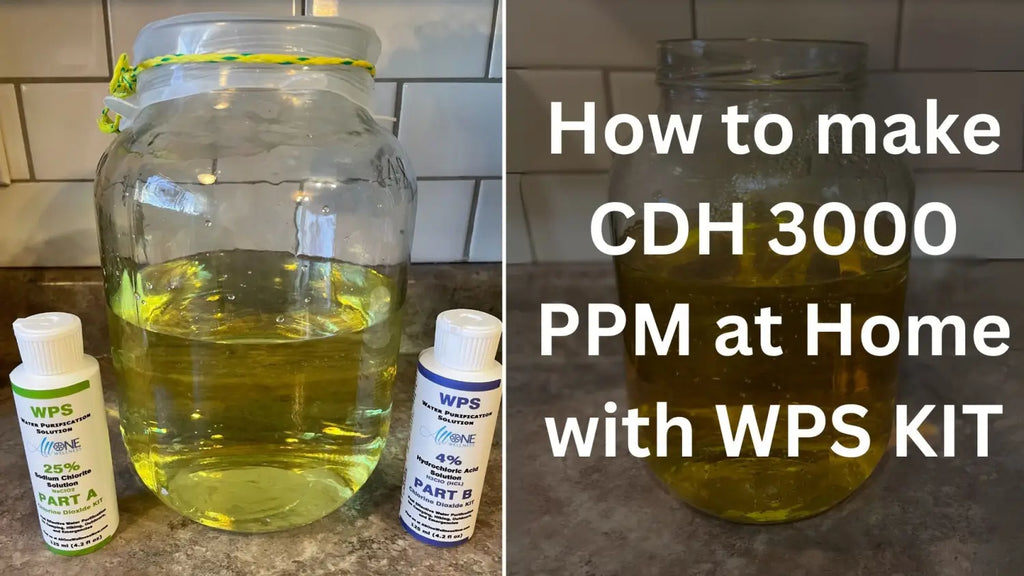How to Make CDH 3000 PPM at Home with WPS KIT
Posted by WISHPOND - DREAMTEAM

What's in your water? We're well aware of the numerous benefits that water provides to our bodies, from preventing dehydration to aiding in the removal of toxins. However, if you're consuming impure water, you might unknowingly be doing more harm than good to your body.
This is one of the reasons why people have chosen to use CDH or Chlorine Dioxide in their water.
What is Chlorine Dioxide?
Chlorine dioxide is a gas with a reddish to yellowish-green color at room temperature, and it readily dissolves in water, making it effective for disinfecting drinking water. When employed in very small quantities for water disinfection, it is safe and does not pose health risks. However, it's important to note that chlorine dioxide shares similarities with household bleach, which means that in excessive quantities, it can become hazardous.
How does it work?
Chlorine dioxide functions by rapidly oxidizing viruses, bacteria, and fungi in water.
In the case of bacteria, when Chlorine Dioxide is introduced to water containing bacterial cells, it triggers a reaction that inhibits protein production. Chlorine dioxide alters the cell membrane proteins and fats, obstructing their intake. As a result, bacteria's cell walls become permeable, and they are subsequently eliminated.
The process of eliminating viruses in water differs from that of bacteria. Chlorine dioxide reacts with peptone, a water-soluble substance originating from the breakdown of proteins into amino acids. Chlorine dioxide eradicates viruses by impeding protein formation.
These mechanisms highlight how chlorine dioxide effectively targets and neutralizes various pathogens in water.
Other Uses and Benefits of Chlorine Dioxide
In addition to purifying drinking water, chlorine dioxide finds applications in various other fields:
- Food and Beverage Production: It serves as an antimicrobial agent for washing fruits and vegetables and is used in poultry processing to enhance food safety.
- Medical Facilities: Chlorine dioxide is utilized for sterilizing medical equipment, surfaces, and tools, playing a critical role in maintaining hygiene standards within healthcare settings. It's important to note that it is not used for curing or treating diseases.
- Paper Processing: Chlorine dioxide is employed in the chemical processing of wood pulp, a fundamental step in the paper manufacturing process. It contributes to the production of high-quality paper products.
These diverse applications highlight the versatility of chlorine dioxide in ensuring safety and cleanliness across various industries.
How to correctly prepare Chlorine Dioxide Holding Solution
Chlorine Dioxide can indeed be employed for water purification at home, but it is essential to strictly adhere to the provided instructions. Here's how to prepare it:
To make 3000 ppm of CDH:
- Use a glass bottle or jar and fill it with 500ml of distilled water.
- Add 25 ml of Sodium Chlorite 22.4% or 25% in to water.
- Add 25 ml of 4% hydrochloric acid as specified, or 25 ml of 50% citric acid in to water. (note: using citric acid may result in a different smell).
- Secure the container with a lid or cap, gently mix the contents, and let it sit for 12 hours at room temperature. You may want to put plastic bag on the lid to make it tighter and not degrade the lid if metal.
- Optional you can use test the solution to make sure its at 3000 PPM.
- Refrigerate the solution for 3 hours before use and make sure to mix it.
Following these steps will ensure the proper preparation of Chlorine Dioxide Solution for safe and effective water purification at home. We have a link to a blog here on how to test CDS or CDH at 3000 PPM
To visually understand the process, we have provided pictures to illustrate the transformation of CDH during its creation. The image on the left shows the solution just after mixing, while the one on the right displays its appearance after 12 hours.

Measurements for making different amounts:
For various quantities of water, you can prepare Chlorine Dioxide Solution as follows:
- For 1 liter of water: Mix 50 ml of sodium chlorite with 50 ml of 4 to 5% hydrochloric acid.
- For 250 ml of water: Combine 12 ml of sodium chlorite with 12 ml of 4 to 5% hydrochloric acid.
- For 330ml of water: Use 16 ml of sodium chlorite and 16 ml of 4 to 5% hydrochloric acid.
Ensure that you store this solution in a refrigerated, in a dark place with the lid tightly secured to prevent off-gassing. When stored properly, it maintains its effectiveness for an extended period. I would make enough for a month or 2 at most.
For detailed instructions on how to use CDH 3000 PPM, you can refer to the website page linked here. In summary, for water purification, add 2 to 5 drops for every liter of water, adjusting the quantity based on the level of impurities present.
Please note that one milliliter of this solution is equivalent to a 3-drop dose of MMS. To align with specific protocols, you can adjust the amounts accordingly. For example, in the case of Protocol 1000, instead of activating 24 drops of MMS and adding them to 1 liter of water, you would add 8ml of CDH instead.
The information directly above provided is for educational purposes only and is not a recommendation. It's crucial to use any substances or solutions with care and follow established guidelines and regulations. If you have any questions or concerns about their use, it's advisable to seek guidance from relevant authorities or healthcare professionals.
It's important to emphasize that Health Canada has issued a warning about the potential health risks associated with using "MMS" as suggested by Jim Humble or Andreas Kalcker. WPS should be used solely for water purification purposes. All One Wellness holds no responsibility for any misuse of our products, and we advocate for responsible and proper use. Your safety and well-being are our top priorities.

